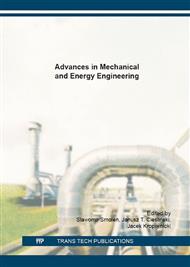[1]
T. Pattanotai, H. Watanabe, K. Okazaki Gasification characteristic of large wood chars with anisotropic structure, Fuel, 117 (2014) 331-339.
DOI: 10.1016/j.fuel.2013.09.030
Google Scholar
[2]
S. Kruczek Boilers. Design and calculations, Wrocław University of Technology, Wrocław, (2001).
Google Scholar
[3]
T. Tanaka, Y. Kawai, M. Sadanari, S. Shida, T. Tsuchimoto Air permeability of Sugi (Cryptomeria Japonica) wood in the three directions, Maderas. Ciencia y tecnología 17(1) (2015) 17 - 28.
DOI: 10.4067/s0718-221x2015005000002
Google Scholar
[4]
W. Jinman, D. Chengyue, L. Yixing. Wood permeability, Journal of Northeast Forestry University, 2(1) (1991) 91-97.
DOI: 10.1007/bf02874797
Google Scholar
[5]
A. L. Redman, H. Bailleres, I. Turner, P. Perre, Mass transfer properties (permeability and mass diffusivity) of four australian hardwood species" Redman et al. "Mass transfer in hardwood, BioResources 7(3) (2012) 3410-3424.
DOI: 10.15376/biores.7.3.3410-3424
Google Scholar
[6]
B. Eilmann, P. Weber, A. Rigling, D. Eckstein Growth reactions of Pinus sylvestris L. and Quercus pubescens Willd. to drought years at a xeric site in Valais, Switzerland, Dendrochronologia, 23 (2006) 121-132.
DOI: 10.1016/j.dendro.2005.10.002
Google Scholar
[7]
P. Baltrėnas, E. Baltrėnaitė, E. Spudulis Biochar from Pine and Birch Morphology and Pore Structure Change by Treatment in Biofilter, Water, Air & Soil Pollution 226(69) (2015) 1-14.
DOI: 10.1007/s11270-015-2295-8
Google Scholar
[8]
V.P. Ikonen, H. Peltola, L. Wilhelmsson, A. Kilpeläinen, H. Väisänen, T. Nuutinen, S. Kellomäki Modeling the distribution of wood properties along the stems of Scots pine (Pinus sylvestris L. ) and Norway spruce (Picea abies (L. ) Karst. ) as affected by silvicultural management, Forest Ecology and Management, 256(6) (2008).
DOI: 10.1016/j.foreco.2008.06.039
Google Scholar
[9]
X. Zhou, J. Ma, Z. Ji, X. Zhang, S. Ramaswamy, F. Xu, R.C. Sun Dilute acid pretreatment differentially affects the compositional and architectural features of Pinus bungeana Zucc. compression and opposite wood tracheid walls, Industrial Crops and Products, 62 (2014).
DOI: 10.1016/j.indcrop.2014.08.035
Google Scholar
[10]
S. Kellomäki Forest resources and sustainable management, Fapet Oy, Helsinki, Finland, (1998).
Google Scholar
[11]
J. Gullichsen, C.J. Fogelholm Chemical pulping, Fapet Oy, Helsinki, Finland, (1999).
Google Scholar
[12]
H. Mäkinen, J. Hynynen Predicting wood and tracheid properties of Scots pine, Forest Ecology and Management, 279(1) (2012) 11-20.
DOI: 10.1016/j.foreco.2012.05.024
Google Scholar
[13]
Y. I. Park, H. Spiecker Variations in the tree-ring structure of Norway spruce (Picea abies) under contrasting climates, Dendrochronologia, 23(2) (2015) 93-104.
DOI: 10.1016/j.dendro.2005.09.002
Google Scholar
[14]
J.W. Seo, M. Smiljanić, M. Wilmking Optimizing cell-anatomical chronologies of Scots pine by stepwise increasing the number of radial tracheid rows included—Case study based on three Scandinavian sites, Dendrochronologia, 32(3) (2014) 205-209.
DOI: 10.1016/j.dendro.2014.02.002
Google Scholar
[15]
M. Plötze, P. Niemz Porosity and pore size distribution of different wood types as determined by mercury intrusion porosimetry, European Journal of Wood and Wood products, 69 (2011) 649-657.
DOI: 10.1007/s00107-010-0504-0
Google Scholar
[16]
C. E. Brewer, V. J. Chuang, C. A. Masiello, H. Gonnermann, X. Gao, B. Dugan, L.E. Driver, P. Panzacchi, K. Zygourakis, C.A. Davies New approaches to measuring biochar density and porosity, Biomass & Bioenergy, 66 (2014) 176-185.
DOI: 10.1016/j.biombioe.2014.03.059
Google Scholar
[17]
M. Somerville, S. Jahanshahi The effect of temperature and compression during pyrolysis on the density of charcoal made from Australian eucalypt wood, Renewable Energy, 80 (2015) 471-478.
DOI: 10.1016/j.renene.2015.02.013
Google Scholar
[18]
D. Kardaś, J. Kluska, S. Polesek-Karczewska Introduction to the gasification of biomass,. Institute of Fluid Flow Machinery, Gdańsk , (2014).
Google Scholar
[19]
R.A. Brown, A.K. Kercher, T.H. Nguyen, D.C. Nagle, W.P. Ball Production and characterization of synthetic wood char for use as surrogates for natural sorbents, Organic Geochemistry, 37(3) (2006) 321-333.
DOI: 10.1016/j.orggeochem.2005.10.008
Google Scholar
[20]
H.E. Desch, J.M. Dinwoodie Timber: Structure, Properties, Conversion and Use, Palgrave Macmillan; 7th edition, (1996).
Google Scholar
[21]
J.D. Conolly, R.A. Hill Dictionary of Terpenoids, Vol. 1, Chapman & Hall, (1991).
Google Scholar


